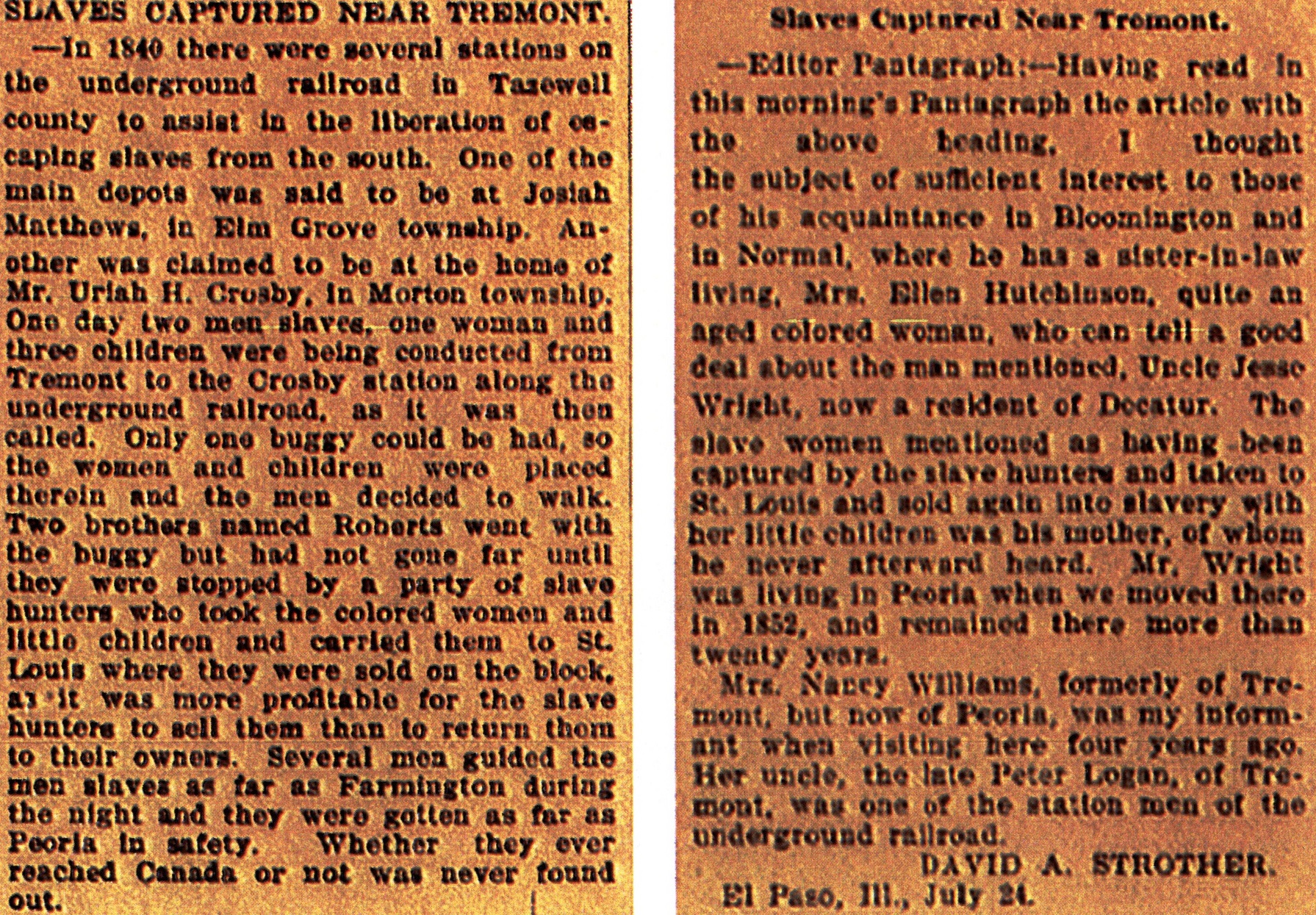Last week we told the story of how Nance Legins-Costley became one of Tazewell County’s earliest African-American homeowners through her purchase of her home lot in 1849.
Remarkable though Nance’s achievement was, other African-Americans owned land in Tazewell County well before 1849. For example, we have previously noted an early Tazewell County settler named Jefferson Frizzel, who was living in Pekin with his wife and children at the time of the 1850 U.S. Census. Frizzel, who came to Tazewell County circa 1833, is identified in census records as “mulatto” (being of both black and white descent).
Frizzel is shown in federal and state land records to have purchased land in Tazewell County on 22 June 1836, 18 March 1837, and 1 Nov. 1839. That would seem to make Frizzel the earliest known African-American to own land in Tazewell County. He and his family are enumerated as Pekin residents in the 1850 U.S. Census, but do not appear in Tazewell County after that.
Earlier this year, however, Susan Rynerson of the Tazewell County Genealogical & Historical Society conducted extensive research in the life and family of Peter Logan, a former slave who settled near Tremont in the 1830s. The fruit of Rynerson’s research was featured in the April 2022 issue of the Tazewell County Genealogical & Historical Society Monthly (pages 328-330), and earlier this month Rynerson spoke about Logan’s life and accomplished during a special Juneteenth Weekend event at the Tazewell County Courthouse on Saturday, June 18.
As Rynerson has shown, Peter Logan was born into slavery in Virginia about 1780. In her TCGHS Monthly article, Rynerson says Logan is mentioned in Emma Scott’s “Early History of Washington, Illinois, and Vicinity,” where Scott says Logan “was owned by a man in Arkansas, who gave him a chance to buy his own freedom and also that of his sister Charlott (sic) and her daughter Nancy . . . . They came and located near Tremont, where he was for many years in the employ of the Dillons and was known for miles around as Uncle Peter Logan.” Rynerson also notes that Scott describes Logan’s sister Charlotte as an excellent cook and says Nancy was a very good student at school.
Among the documents pertaining to Peter Logan’s life that Rynerson located is a deed of sale dated 14 Jan. 1837 whereby Logan purchased land in Sections 22 and 29 of Elm Grove Township, Tazewell County, for $880. Logan built his homestead in Section 22 at what is today the corner of Franklin Street and Springfield Road. He used his land in Section 29 for timber – that land was along Mennonite Church Road just north of Red Shale Hill Road.

This land purchase made Peter Logan the first former slave to become a landowner in Tazewell County. Frizzel had purchased his land about six months earlier than Logan, but it is not known if Frizzel had ever been a slave.
Rynerson found that Peter Logan was enumerated in the 1840 U.S. Census as head of a household that included a woman (probably Charlotte) and a younger woman (probably Nancy). Nancy is the Nancy Hurst who married George Williams in 1845 in Tazewell County. Peter and his sister Charlotte are listed in the same household in the 1850 U.S. Census, but Charlotte died on 31 Oct. 1857, so Peter is found living alone in the 1860 census. His sister Charlotte Hurst was buried in Dillon Cemetery. (Rynerson also has conducted further research on Nancy’s family, but so far has only brought them down to the late 19th century.)
After his sister’s death, Logan began to sell off his land. In March 1859 he sold all by 10 acres of his homestead to Thomas A. Prunty. In 1860 Logan sold the timber lot in Section 29, but the following year that lot was quit-claimed back to him, and he kept the ownership of that land until his death.
In the early 1860s, Logan left Tazewell County and moved to Peoria, where he died 21 March 1866. He was almost certainly buried in Peoria’s Old City Cemetery. Most likely his grave was destroyed or built over after that cemetery was closed.
In his will, Peter Logan named the famous Peoria abolitionist Moses Pettengill as the executor of his estate. He left all his estate to his niece Nance (Hurst) Williams, his only living heir. Pettengill oversaw the sale of Logan’s timber lot on 14 June 1866. Logan’s probate file shows that his coffin was built by J. R. Ziegler, the funeral hearse was provided by B. O. Warner, and his grave was dug by Alexander Forderer, sexton of Peoria’s Old City Cemetery.

One of the most remarkable things Rynerson discovered about Logan were memories of David A. Strother of El Paso, Illinois, that were printed in the 27 July 1900 edition of the Weekly Pantagraph of Bloomington. Strother (who is famous as the first black man to vote in an election following the passage of the 15th Amendment) indicates that Logan’s niece Nancy Williams had informed him in 1896 that her late uncle Peter “was one of the station men of the underground railroad.”
That is the only historical notice that Peter Logan had been involved in the activities of the Underground Railroad in Eastern Tazewell County. But considering Logan’s life story, where he lived, and his association with the Dillons and with Moses Pettengill, it would hardly be surprising that Logan, who had known slavery firsthand, would be active in helping his brothers and sisters to free themselves.












